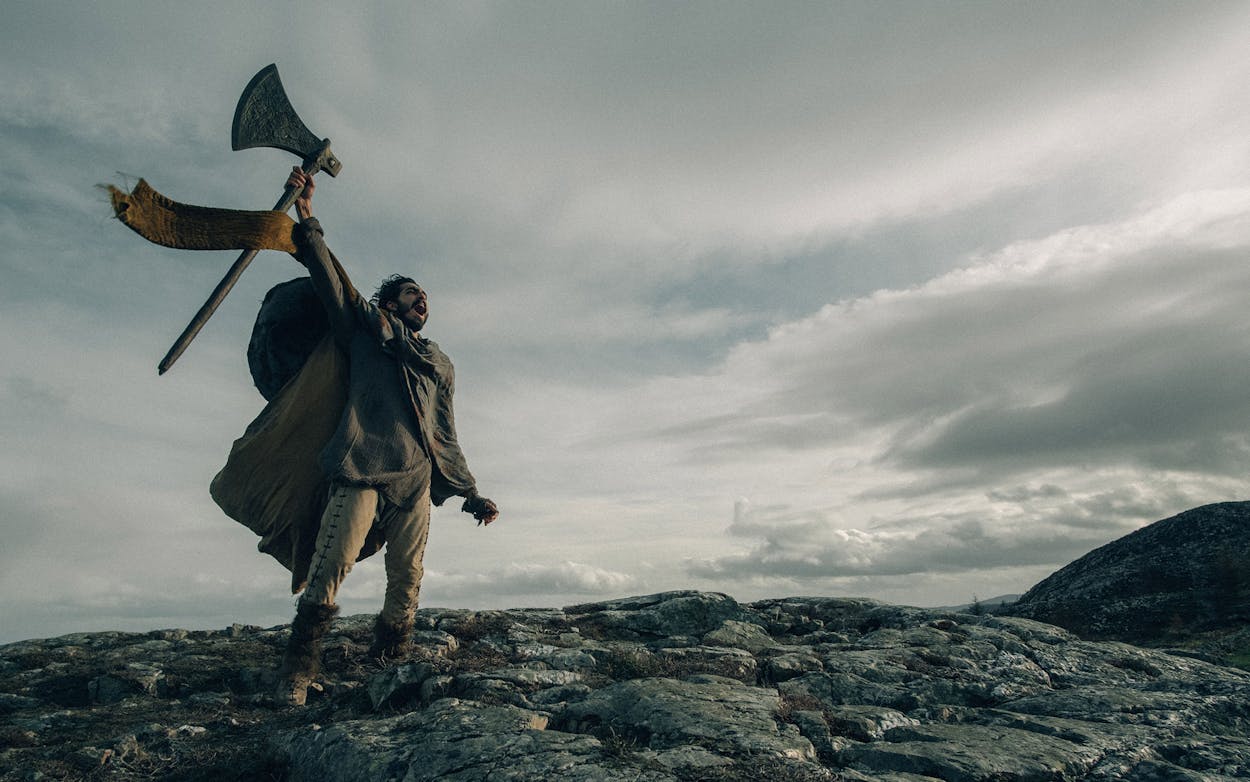Dallas-based writer-director David Lowery was a college student when he first encountered Sir Gawain and the Green Knight, a chivalric romance written by an anonymous author in the late 1300s, not long after the Black Death swept through England. The plot concerns a mysterious, verdant visitor to the Round Table, who on Christmas Day proposes a bizarre, macabre game: if one of King Arthur’s knights lands a blow on him, he’ll return it in kind a year later.
Gawain, Arthur’s nephew, accepts the challenge, beheading the Green Knight, who promptly picks up his head, places it back on his shoulders, and rides away. Most of the poem concerns brave Sir Gawain keeping his dangerous appointment the following year. It’s a good opportunity for undergraduates to learn about Middle English, laws of chivalry, and the guest-host relationship. If it’s not the most accessible read for modern audiences, at least there’s some Arthurian gore, seduction, and mirth thrown in to help it go down easy.
Lowery’s beguiling new film The Green Knight, in theaters this weekend, takes vast and mostly successful liberties in its adaptation, updating the archaic source material into a new kind of modern screen myth. Starring Dev Patel as a scraggly faced libertine nudged by his sorceress mother (Sarita Choudhury) into graver pursuits, The Green Knight is a psychedelic vision quest in chain mail and fox skin.
Fanboy viewers hoping for an Arthurian franchise tentpole will leave confused and perhaps bored by the story’s odd meanderings. Those whose tastes run more toward the surreal and allegorical (think Darren Aronofsky’s Mother! or Ingmar Bergman’s The Seventh Seal) will find The Green Knight a feast for the imagination. Many others will find it simply weird—for better, for worse, or in the Middle English sense meaning “supernatural” or “connected to fate or destiny.”
Lowery is the avowedly atheist son of a University of Dallas theologian. Perhaps that helps explain why The Green Knight is so full of original and nonconformist notions about spirituality, life and death, courage and honor, and even the true meaning of Christmas. At one point, as Gawain shelters in the castle of an unnamed Lord and Lady (Joel Edgerton and Alicia Vikander), they discuss why the mysterious knight is green—the color of living things, but also of rot. “Red is the color of lust, but green is what lust leaves behind,” the Lady tells Gawain, whom she’s hoping to seduce. “Green is what’s left when ardor fades, when passion dies and we die too.”
Death hangs like a mist over Gawain’s quest. It’s hopefully not spoiling too much to say that, after the beheading that sets off the plot of The Green Knight, Gawain barely lifts his sword. Gawain’s mission is not about conquest or glory—even if he rides out hoping it to be so. Not all of us, Lowery seems to be saying, are destined to slay dragons or rescue maidens or defeat vast armies single-handedly—or to save the world. If we’ve gotten that idea from watching too many movies, perhaps we’ve been misled. But there are certain elements of human destiny that we all share, and The Green Knight focuses on those.
If The Green Knight is an unconventional sword-and-sorcery film, it’s even more outside the box as a Christmas movie. Lowery’s titular silent knight has the countenance of a tree, and when Gawain fells him on Christmas Day, he sets in motion a story that evokes modern comparative-religion ideas about dying-and-reviving solar kings whose rites come at the dawn of the new year (cf. James Frazer’s The Golden Bough). The Green Knight may never make it onto the Hallmark Channel, but at least we’ll all have something edgier to say than “Die Hard” next time someone asks us our favorite holiday film.
Lowery has made an interesting career in Hollywood without permanently decamping from his hometown, following in the independent-minded footsteps of Texas luminaries Terrence Malick and Richard Linklater. Like Linklater especially, Lowery seems to switch off between studio-developed properties like Pete’s Dragon (2016) or the upcoming Peter Pan & Wendy and more offbeat, self-defined productions like this one. Audiences are most likely to have seen his The Old Man & the Gun (2018), a Robert Redford vehicle that never found its tone around a shaky lead performance, or his arthouse gem A Ghost Story (2017), featuring Casey Affleck in a white sheet with eyeholes cut out, haunting the house he once shared with a pie-eating Rooney Mara.
Read Next: Dallas’s David Lowery Won’t Leave His Old Haunts
It’s to the latter, fortunately, that The Green Knight hews closest. Both films make ingenious use of visual effects on a tight budget, both are supernatural and somber in outlook, and both end with extensive, almost dialogue-free sequences that do remarkable things with narrative. A Ghost Story is the more flawless film, but The Green Knight, though it suffers sometimes from its commitment to faux-Shakespearean dialogue, has a more obvious sense of fun, with its talking animals, virgin ghosts, diaphanous giants, and so on. It’s less streamlined, more a treat—and a trip—to take in.
Most importantly, A Ghost Story was visually self-limiting, confining itself to the interior of a house for most of its run-time. It’s a great small movie. The Green Knight, on the other hand, traverses dreamscape after dreamscape. It’s a wonderful, florid tangle worth losing oneself in, as Gawain does as he attempts to surrender to nature in the film’s final section. Whether or not he emerges from his experience renewed and reborn, at the very least this fourteenth-century source material does.
- More About:
- Film & TV






